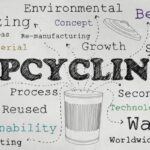I. Understanding Upcycling: Transforming Waste into Value
II. The Process of Recycling: Breaking Down Materials for Reuse
III. Key Differences Between Upcycling and Recycling: Concepts and Benefits
Understanding Upcycling: Transforming Waste into Value
Have you ever looked at an old piece of furniture and thought, “This could be something amazing”? That’s the spirit of upcycling! Upcycling is all about taking items that might otherwise be thrown away and giving them a second life, often in a more valuable or artistic form. It’s a creative way to reduce waste while unleashing your inner artist.
What is Upcycling?
At its core, upcycling is the process of repurposing waste materials or unwanted products into something of higher quality or value. Unlike recycling—which often breaks materials down into raw form—upcycling keeps the original item in one piece, enhancing it and transforming it into something new and useful.
Imagine turning an old ladder into a quirky bookshelf or using wine bottles to create stunning candle holders. The possibilities are endless!
The Benefits of Upcycling
Upcycling isn’t just a fun way to express creativity; it also comes with a host of benefits:
- Environmental Impact: By reusing items, upcycling helps reduce waste in landfills and lowers the demand for new materials. This means less energy is used and fewer resources are depleted.
- Creativity and Self-Expression: Upcycling allows you to unleash your creativity. Instead of sticking to what’s available in stores, you can create unique, one-of-a-kind pieces that reflect your style.
- Cost-Effective: Why spend a fortune on new decor or furniture when you can transform what you already have? Upcycling can save you money while also enhancing your home’s aesthetic.
- Community Engagement: Many people enjoy sharing their upcycling projects online or at local markets. It fosters a sense of community and encourages others to think creatively about waste.
Getting Started with Upcycling
If you’re intrigued by the idea of upcycling, the good news is that you don’t need to be a DIY expert to start! Here are some simple steps to kick off your upcycling journey:
- Start Small: Look around your home for items you no longer use. Old t-shirts can become reusable bags, or glass jars can be turned into stylish storage containers.
- Gather Inspiration: Websites like Pinterest and Instagram are treasure troves for upcycling ideas. You’ll find countless tutorials and stunning examples that can spark your imagination!
- Embrace Imperfection: Remember, upcycling is about creativity, not perfection. Don’t be afraid to experiment and make mistakes—they often lead to the most unique results.
- Share Your Creations: Once you’ve completed a project, show it off! Share your work with friends, family, or on social media. You might inspire someone else to start their upcycling adventure!
In a world that often encourages disposability, upcycling invites us to think differently about the items we own. It’s a rewarding way to reduce waste, express your creativity, and make a positive impact, one project at a time. So, what will you upcycle today?
The Process of Recycling: Breaking Down Materials for Reuse
Recycling is one of those buzzwords we hear a lot, but what does it really mean? In simple terms, recycling is the process of transforming waste materials into new products. This not only helps reduce the amount of waste we produce but also conserves natural resources and energy. Let’s dive into how recycling works and why it’s so essential for our environment.
How Does Recycling Work?
Recycling often involves a multi-step process that can vary depending on the type of material being recycled. Here’s a general overview of how it typically goes down:
- Collection: The first step is gathering recyclable materials. This usually happens through curbside pickup, drop-off centers, or collection drives. Have you ever wondered what happens to your recycling bin after it’s picked up? It’s a bit of a journey!
- Sorting: Once collected, the materials are taken to a recycling facility, where they’re sorted into different categories (like paper, plastics, metals, and glass). This is crucial because different materials require different processing methods.
- Cleaning: Next, the sorted materials undergo cleaning. For instance, plastics might need to be washed to remove food residue, while metals may be stripped of labels and coatings. This step ensures that contaminants don’t interfere with the recycling process.
- Processing: After cleaning, the materials are processed. This could involve shredding, melting, or pulping them, depending on the type. For example, glass is crushed into small pieces, while paper is turned into a slurry.
- Manufacturing New Products: Finally, the processed materials are transformed into new products! Recycled materials can be used to create anything from new bottles and cans to clothing and even furniture. Isn’t that cool?
Why is Recycling Important?
Recycling isn’t just a trendy thing to do; it has significant benefits for our planet:
- Conserves Resources: By recycling, we reduce the need for new raw materials. This means fewer trees cut down for paper, less mining for metals, and less drilling for oil.
- Saves Energy: The recycling process often uses less energy compared to producing new products from scratch. For instance, recycling aluminum saves up to 95% of the energy required to produce it from bauxite ore!
- Reduces Landfill Waste: Recycling helps divert waste from landfills, prolonging their lifespan and reducing the environmental impact that landfills have on our communities.
- Encourages Sustainable Practices: By participating in recycling, we foster a culture of sustainability. It’s a simple action that can lead to significant changes in how our society views waste and resource management.
Getting Involved in Recycling
Want to make a difference? Getting involved in recycling is easier than you think! Here are a few tips:
- Check your local recycling guidelines to know what materials are accepted.
- Make it easy by setting up a recycling station at home.
- Encourage your friends and family to recycle too!
- Consider joining or supporting local recycling initiatives and programs.
Recycling might seem like a small act, but it has a massive impact. By understanding the process and embracing it in our lives, we can all contribute to a healthier planet. So, the next time you toss that plastic bottle in the recycling bin, remember: you’re doing your part to transform waste into a valuable resource!
Key Differences Between Upcycling and Recycling: Concepts and Benefits
Hey there! If you’ve ever found yourself wondering about the buzz around upcycling and recycling, you’re definitely not alone. Both concepts are super popular in the sustainability scene, but they have distinct differences that are worth exploring. Let’s dive in and break it down!
What Are Upcycling and Recycling?
First things first, let’s clarify what each term really means:
- Recycling is the process of taking waste materials—like plastics, paper, and metals—and breaking them down to create new products. Think of it like a factory reset for materials!
- Upcycling, on the other hand, involves repurposing or transforming old items into something new and often more valuable without breaking them down. It’s more about creativity and innovation.
The Process: How They Work
When we talk about recycling, it involves a systematic process:
- Collection of recyclable materials
- Sorting and cleaning
- Processing and transforming these materials
- Manufacturing new products from the recycled materials
Upcycling skips a few of those steps. Instead of going back to square one, you take something that might be considered “waste” and give it a new life through your own creativity. For example, turning an old wooden pallet into a stylish coffee table is upcycling at its finest!
Benefits of Each Approach
Both upcycling and recycling have their own unique advantages that contribute to a more sustainable world:
- Environmental Impact: Recycling helps reduce waste in landfills and conserves natural resources by utilizing existing materials. Upcycling further reduces waste by preventing items from being discarded in the first place.
- Creativity and Individuality: Upcycling allows you to express yourself! Each upcycled piece tells a story and reflects your personal style. Recycling, while essential, often results in generic products.
- Economic Benefits: Upcycling can save money since you’re reusing materials instead of purchasing new ones. Recycling creates jobs in the collection and processing sectors, contributing positively to the economy.
Which One Should You Choose?
So, which approach is better? Well, that depends on your goals! If you’re looking to get crafty and add a personal touch to your space, then upcycling is your jam. But if you want to contribute to a larger system of waste management and sustainability, recycling is equally essential.
In the end, both upcycling and recycling play vital roles in creating a sustainable future. Whether you’re channeling your inner designer or diligently sorting your recyclables, you’re helping to make a difference. So why not embrace both? There’s a whole world of creativity and responsible living waiting for you!




Comments